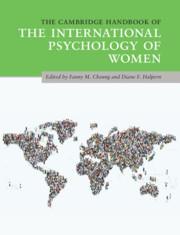Book contents
- The Cambridge Handbook of the International Psychology of Women
- The Cambridge Handbook of the International Psychology of Women
- Copyright page
- Dedication
- Contents
- Figures
- Tables
- Contributors
- Acknowledgments
- Section 1 The Underpinnings of Sex and Gender and How to Study Them
- 1 International and Intersectional Perspectives on the Psychology of Women
- 2 Feminist Theory and Methodologies
- 3 The Contents and Discontents of the Nature–Nurture Debate
- 4 Sex, Gender, and Sexuality
- 5a Sex Differences on the Brain
- 5b Sex/Gender Differences in the Brain and their Relationship to Behavior
- Section 2 Developmental Perspectives of the International Psychology of Women
- Section 3 Cognitive and Social Factors
- Section 4 Work and Family Issues
- Section 5 Inequality and Social Justice
- Section 6 Health and Well-Being
- Epilogue Some Final Thoughts and Take-Home Messages
- Index
- References
4 - Sex, Gender, and Sexuality
from Section 1 - The Underpinnings of Sex and Gender and How to Study Them
Published online by Cambridge University Press: 20 July 2020
- The Cambridge Handbook of the International Psychology of Women
- The Cambridge Handbook of the International Psychology of Women
- Copyright page
- Dedication
- Contents
- Figures
- Tables
- Contributors
- Acknowledgments
- Section 1 The Underpinnings of Sex and Gender and How to Study Them
- 1 International and Intersectional Perspectives on the Psychology of Women
- 2 Feminist Theory and Methodologies
- 3 The Contents and Discontents of the Nature–Nurture Debate
- 4 Sex, Gender, and Sexuality
- 5a Sex Differences on the Brain
- 5b Sex/Gender Differences in the Brain and their Relationship to Behavior
- Section 2 Developmental Perspectives of the International Psychology of Women
- Section 3 Cognitive and Social Factors
- Section 4 Work and Family Issues
- Section 5 Inequality and Social Justice
- Section 6 Health and Well-Being
- Epilogue Some Final Thoughts and Take-Home Messages
- Index
- References
Summary
This chapter examines and defines a number of terms fundamental to understanding women including sex, gender, gender identity, gender roles, sexual orientation, sexual identity, sexual and gender fluidity, and gender/sex. Although these aspects of being a woman are connected, they are nonetheless distinct. To understand what it means to be a woman, it is important to understand the complexities of each of these concepts both within and across cultures as well as to take an intersectional approach that considers all of a woman’s identities. We propose that the answer to the question of who is a woman is that women are those individuals who identify as being a woman, regardless of their sex assigned at birth, gender roles, sexual orientation, or sexual identity. We also concluded that although there are certainly some biological differences between men and women, women’s sexuality and sexual well-being can be best understood from a social constructionist perspective that takes sociocultural influences into account.
Keywords
- Type
- Chapter
- Information
- Publisher: Cambridge University PressPrint publication year: 2020
References
Suggested Readings

E. Sandra Byers is Professor and Chair in the Department of Psychology at University of New Brunswick in Fredericton, New Brunswick, Canada and a Research Fellow of the Royal Society of Canada. She is the author or co-author of more than 180 journal articles and book chapters, mostly on aspects of human sexuality, as well as of a popular textbook on human sexuality. Byers is a past president of the International Academy of Sex Research and the Canadian Sex Research Forum, a fellow of the Society for the Scientific Study of Sexuality and the Canadian Psychological Association, and is on the editorial boards of a number of scholarly journals. She has won numerous awards including the Donald O. Hebb Award for Distinguished Contribution to Psychology as a Profession from the Canadian Psychological Association in 2010, the Kinsey Award for outstanding contributions to the field of sex research, sex therapy, or sexology from the Society for the Scientific Study of Sexuality in 2013, and the Outstanding Contribution Award from the Canadian Sex Research Forum. She is also a licensed clinical psychologist with a part-time private practice primarily focused on the treatment of sexual concerns and problems.
Karen L. Blair is an Assistant Professor of Psychology and has affiliations with St. Francis Xavier, Acadia and Trent Universities in Nova Scotia and Ontario, Canada, is founder of KLB Research and president of LGBTQ Psychology Canada. Blair studies the role that social support for relationships plays in the development, maintenance, and dissolution of relationships, sexuality in same-sex relationships, LGBTQ psychology, Holocaust education, and the connections between relationships, social prejudices, and health. More information about her work can be found on her website: www.drkarenblair.com. Blair grew up in Winnipeg, Canada and has lived in Manitoba, Ontario, Nova Scotia, and Utah (United States). She attended University of Guelph, Acadia, and Queen’s University in Canada with a postdoc at the University of Utah. Blair taught English in Thailand, and has spent significant amounts of time in Prague, Czech Republic. She has international collaborations in the United States, the United Kingdom, the Czech Republic, Turkey, and New Zealand. Blair currently lives in Peterborough, ON with her wife, who is also an academic, and their three dogs.



